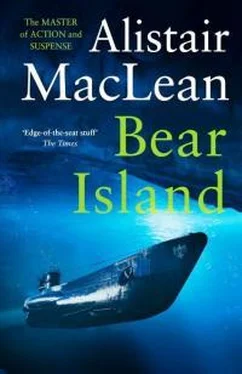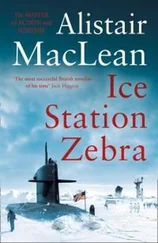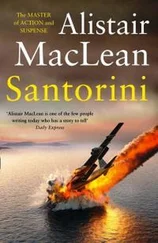At anchor, the Morning Rose could comfortably have ridden out the threatened blow, but the trouble was that the Morning Rose was not at anchor. She was tied up alongside a crumbling limestone jetty – neither iron nor wooden structures would have lasted for any time in those stormy and bitter waters – that had first been constructed by Lerner and the Deutsche Seefischerei-Verein about the turn of the century and then improved upon – if that were the term – by the International Geophysical Year expedition that had summered there. The jetty, which would have been condemned out of hand and forbidden for public use almost anywhere else in the northern hemisphere, had originally been T-shaped, but the left arm of the T was now all but gone while the central section leading to the shore was badly eaten away on its southward side. It was against this dangerously dilapidated structure that the Morning Rose was beginning to pound with increasing force as the south-easterly seas caught her under the starboard quarter and the cushioning effect as the trawler struck heavily and repeatedly against the jetty was sufficient to make those working on deck stagger and clutch on to the nearest support. It was difficult to say what effect this was having on the Morning Rose , for apart from the scratching and slight indentations of the plates none was visible, but trawlers are legendarily tough and it was unlikely that she was coming to any great harm: but what was coming to harm, and very visibly so, was the jetty itself, for increasingly large chunks of masonry were beginning to fall into the Sor-hamna with dismaying frequency, and as most of our fuel, provisions and equipment still stood there, the seemingly imminent collapse of the pier into the sea was not a moment to be viewed with anything like equanimity.
When we’d first come alongside shortly before noon, the unloading had gone ahead very briskly and smoothly indeed, except for the unloading of Miss Haynes’s snarling pooches. Even before we’d tied up, the after derrick had the sixteen-foot work-boat in the water and three minutes later an only slightly smaller fourteen-footer with an outboard had followed it: those boats were to remain with us. Within ten minutes the specially strengthened for’ard derrick had lifted the weirdly-shaped – laterally truncated so as to have a flat bottom – mock-up of the central section of a submarine over the side and lowered it gently into the water, where it floated with what appeared to be perfect stability, no doubt because of its four tons of cast-iron ballast. It was when the mockup conning-tower was swung into position to be bolted on to the central section of the submarine that the trouble began.
It just wouldn’t bolt on. Goin and Heissman and Stryker, the only three who had observed the original tests, said that in practice it had operated perfectly: clearly, it wasn’t operating perfectly now. The conning-tower section, elliptical in shape, was designed to settle precisely over a four-inch vertical flange in the centre of the mid-section, but settle it just wouldn’t do: it turned out that one of the shallow curves at the foot of the conning-tower was at least a quarter-inch out of true, a fact that was almost certainly due to the pounding that we’d taken on the way up from Wick: just one lashing not sufficiently bar-taut would have permitted that microscopic freedom of vertical movement that would have allowed the tiny distortion to develop.
The solution was simple – just to hammer the offending curve back into shape – and in a dockyard with skilled platelayers available this would probably have been no more than a matter of minutes. But we’d neither technical facilities nor skilled labour available and the minutes had now stretched into hours. A score of times now the for’ard derrick had offered up the offending conning-tower piece to the flange: a score of times it had had to be lifted again and painstakingly assaulted by hammers. Several times a perfect fit had been achieved where it had been previously lacking only to find the distortion had mysteriously and mischievously transferred itself a few inches farther along the metal. Nor, now, despite the fact that the submarine section was in the considerable lee afforded by both pier and vessel, were matters being made any easier by the little waves that were beginning to deep around the bows of the Morning Rose and rock it, gently at first but with increasing force, to the extent that the ultimate good fit was clearly going to depend as much on the luck of timing as the persuasion of the hammers.
Captain Imrie wasn’t frantic with worry for the sound reason that it wasn’t in his nature to become frantic about anything, but the depth of his concern was evident enough from the fact that he had not only skipped lunch but hadn’t as much as fortified himself with anything stronger than coffee since our arrival in the Sor-hamna. His main concern, apart from the well-being of the Morning Rose – he clearly didn’t give a damn about his passengers – was to get the foredeck cleared of its remaining deck cargo because, as I’d heard Otto rather unnecessarily and unpleasantly reminding him, it was part of his contractual obligations to land all passengers and cargo before departure for Hammerfest. And, of course, what was exercising Captain Imrie’s mind so powerfully was that, with darkness coming on and the weather blowing up, the for’ard deck cargo had not yet been unloaded and would not be until the fore derrick was freed from its present full-time occupation of holding the conning-tower suspended over the mid-section.
The one plus factor about Captain Imrie’s concentration was that it gave him little time to worry about Halliday’s disappearance. More precisely, it gave him little time to try to do anything constructive about it, for I knew it was still very much on his mind from the fact that he had taken time off to tell me that upon his arrival in Hammerfest his first intention would be to contact the law. There were two things I could have said at this stage, but I didn’t. The first was that I failed to see what earthly purpose this could serve – it was just, I suppose, that he felt that he had to do something, anything, however ineffectual that might be: the second was that I felt quite certain that he would never get the length of Hammerfest in the first place, although just then hardly seemed the time to tell him why I thought so. He wasn’t then in the properly receptive mood: I had hopes that he would be shortly after he had left Bear Island.
I went down the screeching metal gangway – its rusty iron wheels, apparently permanently locked in position, rubbed to and fro with every lurch of the Morning Rose – and made my way along the ancient jetty. A small tractor and a small Sno-Cat – they had been the third and fourth items to be unloaded from the trawler’s after-deck – were both equipped with towing sledges and everybody from Heissman downwards was helping to load equipment aboard those sledges for haulage up to the huts that lay on the slight escarpment not more than twenty yards from the end of the jetty. Everybody was not only helping, they were helping with a will: when the temperature is fifteen degrees below freezing the temptation to dawdle is not marked. I followed one consignment up to the huts.
Unlike the jetty, the huts were of comparatively recent construction and in good condition, relics from the latest IGY – there could have been no possible economic justification in dismantling them and taking them back to Norway. They were not built of the modern kapok, asbestos and aluminium construction so favoured by modern expeditions in Arctic regions as base headquarters: they were built – although admittedly pre-sectioned – in the low-slung chalet design fairly universally found in the higher Alpine regions of Europe. They had about them that four-square hunch-shouldered look, the appearance of lowering their heads against the storm, that made it seem quite likely that they would still be there in a hundred years’ time. Provided they are not exposed to prevailing high winds and the constant fluctuation of temperature above and below the freezing point, man-made structures can last almost indefinitely in the deep-freeze of the high Arctic.
Читать дальше









